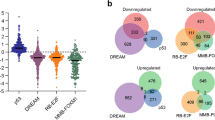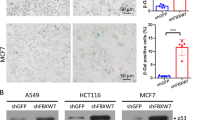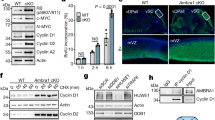Abstract
Activated oncogenes induce compensatory tumour-suppressive responses, such as cellular senescence or apoptosis, but the signals determining the main outcome remain to be fully understood1,2. Here, we uncover a role for Cdk2 (cyclin-dependent kinase 2) in suppressing Myc-induced senescence. Short-term activation of Myc promoted cell-cycle progression3 in either wild-type or Cdk2 knockout4,5 mouse embryo fibroblasts (MEFs). In the knockout MEFs, however, the initial hyper-proliferative response was followed by cellular senescence. Loss of Cdk2 also caused sensitization to Myc-induced senescence in pancreatic β-cells or splenic B-cells in vivo, correlating with delayed lymphoma onset in the latter. Cdk2−/− MEFs also senesced upon ectopic Wnt signalling or, without an oncogene, upon oxygen-induced culture shock6. Myc also causes senescence in cells lacking the DNA repair protein Wrn7. However, unlike loss of Wrn8, loss of Cdk2 did not enhance Myc-induced replication stress, implying that these proteins suppress senescence through different routes. In MEFs, Myc-induced senescence was genetically dependent on the ARF–p53–p21Cip1 and p16INK4a–pRb pathways, p21Cip1 and p16INK4a being selectively induced in Cdk2−/− cells. Thus, although redundant for cell-cycle progression and development4,5,9,10,11,12, Cdk2 has a unique role in suppressing oncogene- and/or stress-induced senescence1. Pharmacological inhibition of Cdk2 induced Myc-dependent senescence in various cell types, including a p53-null human cancer cell line. Our data warrant re-assessment of Cdk2 as a therapeutic target in Myc- or Wnt-driven tumours.
This is a preview of subscription content, access via your institution
Access options
Subscribe to this journal
Receive 12 print issues and online access
$209.00 per year
only $17.42 per issue
Buy this article
- Purchase on Springer Link
- Instant access to full article PDF
Prices may be subject to local taxes which are calculated during checkout





Similar content being viewed by others
References
Campisi, J. & d'Adda di Fagagna, F. Cellular senescence: when bad things happen to good cells. Nature Rev. Mol. Cell Biol. 8, 729–740 (2007).
Schmitt, C. A. Cellular senescence and cancer treatment. Biochim. Biophys. Acta (2006).
Amati, B., Alevizopoulos, K. & Vlach, J. Myc and the cell cycle. Front. Biosci. 3, D250–D268 (1998).
Ortega, S. et al. Cyclin-dependent kinase 2 is essential for meiosis but not for mitotic cell division in mice. Nature Genet. 35, 25–31 (2003).
Berthet, C., Aleem, E., Coppola, V., Tessarollo, L. & Kaldis, P. Cdk2 knockout mice are viable. Curr. Biol. 13, 1775–1785 (2003).
Parrinello, S. et al. Oxygen sensitivity severely limits the replicative lifespan of murine fibroblasts. Nature Cell Biol. 5, 741–747 (2003).
Grandori, C. et al. Werner syndrome protein limits MYC-induced cellular senescence. Genes Dev. 17, 1569–1574 (2003).
Robinson, K., Asawachaicharn, N., Galloway, D. A. & Grandori, C. c-Myc accelerates S-Phase and requires WRN to avoid replication stress. PLoS One 4, e5951 (2009).
Santamaria, D. et al. Cdk1 is sufficient to drive the mammalian cell cycle. Nature 448, 811–815 (2007).
Martin, A. et al. Cdk2 is dispensable for cell cycle inhibition and tumor suppression mediated by p27(Kip1) and p21(Cip1). Cancer Cell 7, 591–598 (2005).
Aleem, E., Kiyokawa, H. & Kaldis, P. Cdc2–cyclin E complexes regulate the G1/S. phase transition. Nature Cell Biol. 7, 831–836 (2005).
Satyanarayana, A., Hilton, M. B. & Kaldis, P. p21 inhibits Cdk1 in the absence of Cdk2 to maintain the G1/S. phase DNA damage checkpoint. Mol. Biol. Cell (2007).
Deb-Basu, D., Karlsson, A., Li, Q., Dang, C. V. & Felsher, D. W. MYC can enforce cell cycle transit from G1 to S and G2 to S, but not mitotic cellular division, independent of p27-mediated inihibition of cyclin E/CDK2. Cell Cycle 5, 1348–1355 (2006).
Felsher, D. W., Zetterberg, A., Zhu, J., Tlsty, T. & Bishop, J. M. Overexpression of MYC causes p53-dependent G2 arrest of normal fibroblasts. Proc. Natl Acad. Sci. USA 97, 10544–10548 (2000).
Deb-Basu, D., Aleem, E., Kaldis, P. & Felsher, D. W. CDK2 is required by MYC to induce apoptosis. Cell Cycle 5, 1342–1347 (2006).
Pelengaris, S., Khan, M. & Evan, G. I. Suppression of Myc-induced apoptosis in β cells exposes multiple oncogenic properties of Myc and triggers carcinogenic progression. Cell 109, 321–334 (2002).
Vafa, O. et al. c-Myc can induce DNA damage, increase reactive oxygen species, and mitigate p53 function: a mechanism for oncogene-induced genetic instability. Mol. Cell 9, 1031–1044 (2002).
Pusapati, R. V. et al. ATM promotes apoptosis and suppresses tumorigenesis in response to Myc. Proc. Natl Acad. Sci. USA 103, 1446–1451 (2006).
Shreeram, S. et al. Regulation of ATM/p53-dependent suppression of myc-induced lymphomas by Wip1 phosphatase. J. Exp. Med. 203, 2793–2799 (2006).
Gorrini, C. et al. Tip60 is a haplo-insufficient tumour suppressor required for an oncogene-induced DNA damage response. Nature 448, 1063–1067 (2007).
Reimann, M. et al. The Myc-evoked DNA damage response accounts for treatment resistance in primary lymphomas in vivo. Blood (2007).
Maclean, K. H., Kastan, M. B. & Cleveland, J. L. Atm deficiency affects both apoptosis and proliferation to augment Myc-induced lymphomagenesis. Mol. Cancer Res. 5, 705–711 (2007).
Dominguez-Sola, D. et al. Non-transcriptional control of DNA replication by c-Myc. Nature 448, 445–451 (2007).
Louis, S. F. et al. c-Myc induces chromosomal rearrangements through telomere and chromosome remodeling in the interphase nucleus. Proc. Natl Acad. Sci. USA 102, 9613–9618 (2005).
Gao, P. et al. HIF-dependent antitumorigenic effect of antioxidants in vivo. Cancer Cell 12, 230–238 (2007).
Deans, A. J. et al. Cyclin-dependent kinase 2 functions in normal DNA repair and is a therapeutic target in BRCA1-deficient cancers. Cancer Res. 66, 8219–8226 (2006).
Woo, R. A. & Poon, R. Y. Activated oncogenes promote and cooperate with chromosomal instability for neoplastic transformation. Genes Dev. 18, 1317–1330 (2004).
Ray, S. et al. MYC can induce DNA breaks in vivo and in vitro independent of reactive oxygen species. Cancer Res. 66, 6598–6605 (2006).
Nilsson, J. A. et al. Targeting ornithine decarboxylase in Myc-induced lymphomagenesis prevents tumor formation. Cancer Cell 7, 433–444 (2005).
Krimpenfort, P., Quon, K. C., Mooi, W. J., Loonstra, A. & Berns, A. Loss of p16Ink4a confers susceptibility to metastatic melanoma in mice. Nature 413, 83–86 (2001).
Martins, C. P. & Berns, A. Loss of p27(Kip1) but not p21(Cip1) decreases survival and synergizes with MYC in murine lymphomagenesis. EMBO J. 21, 3739–3748 (2002).
Macias, E., Kim, Y., Miliani de Marval, P. L., Klein-Szanto, A. & Rodriguez-Puebla, M. L. Cdk2 deficiency decreases ras/CDK4-dependent malignant progression, but not myc-induced tumorigenesis. Cancer Res. 67, 9713–9720 (2007).
Feldser, D. M. & Greider, C. W. Short telomeres limit tumor progression in vivo by inducing senescence. Cancer Cell 11, 461–469 (2007).
Cosme-Blanco, W. et al. Telomere dysfunction suppresses spontaneous tumorigenesis in vivo by initiating p53-dependent cellular senescence. EMBO Rep. 8, 497–503 (2007).
Tetsu, O. & McCormick, F. Proliferation of cancer cells despite CDK2 inhibition. Cancer Cell 3, 233–245 (2003).
Sugimoto, K. et al. Frequent mutations in the p53 gene in human myeloid leukemia cell lines. Blood 79, 2378–2383 (1992).
Chi, Y. et al. Identification of CDK2 substrates in human cell lysates. Genome Biol. 9, R149 (2008).
Matsuura, I. et al. Cyclin-dependent kinases regulate the antiproliferative function of Smads. Nature 430, 226–231 (2004).
Alevizopoulos, K., Vlach, J., Hennecke, S. & Amati, B. Cyclin E and c-Myc promote cell proliferation in the presence of p16INK4a and of hypophosphorylated Retinoblastoma-family proteins. EMBO J. 16, 5322–5333 (1997).
Vlach, J., Hennecke, S., Alevizopoulos, K., Conti, D. & Amati, B. Growth arrest by the cyclin-dependent kinase inhibitor p27Kip1 is abrogated by c-Myc. EMBO J. 15, 6595–6604 (1996).
Schmitt, C. A. et al. A senescence program controlled by p53 and p16INK4a contributes to the outcome of cancer therapy. Cell 109, 335–346 (2002).
Wu, C. H. et al. Cellular senescence is an important mechanism of tumor regression upon c-Myc inactivation. Proc. Natl Acad. Sci. USA (2007).
Goga, A., Yang, D., Tward, A. D., Morgan, D. O. & Bishop, J. M. Inhibition of CDK1 as a potential therapy for tumors over-expressing MYC. Nature Med. 13, 820–827 (2007).
Morgenstern, J. P. & Land, H. Advanced mammalian gene transfer: high titre retroviral vectors with multiple drug selection markers and a complementary helper-free packaging cell line. Nucleic Acids Res. 18, 3587–3596 (1990).
Littlewood, T. D., Hancock, D. C., Danielian, P. S., Parker, M. G. & Evan, G. I. A modified oestrogen receptor ligand-binding domain as an improved switch for the regulation of heterologous proteins. Nucleic Acids Res. 23, 1686–1690 (1995).
Hemann, M. T. et al. Evasion of the p53 tumour surveillance network by tumour-derived MYC mutants. Nature 436, 807–811 (2005).
Fanidi, A., Harrington, E. A. & Evan, G. I. Cooperative interaction between c-myc and bcl-2 proto-oncogenes. Nature 359, 554–556 (1992).
Bahram, F., Wu, S., Oberg, F., Luscher, B. & Larsson, L. G. Posttranslational regulation of Myc function in response to phorbol ester/interferon-γ-induced differentiation of v-Myc-transformed U-937 monoblasts. Blood 93, 3900–3912 (1999).
Brooks, E. E. et al. CVT-313, a specific and potent inhibitor of CDK2 that prevents neointimal proliferation. J. Biol. Chem. 272, 29207–29211 (1997).
Murga, M. et al. Global chromatin compaction limits the strength of the DNA damage response. J. Cell Biol. 178, 1101–1108 (2007).
Adams, J. M. et al. The c-myc oncogene driven by immunoglobulin enhancers induces lymphoid malignancy in transgenic mice. Nature 318, 533–538 (1985).
Schmitt, C. A. et al. Dissecting p53 tumor suppressor functions in vivo. Cancer Cell 1, 289–298 (2002).
Dimri, G. P. et al. A biomarker that identifies senescent human cells in culture and in aging skin in vivo. Proc. Natl Acad. Sci. USA 92, 9363–9367 (1995).
Acknowledgements
We thank C. Gorrini, E. Guccione, A, Magnifico, G. Natoli, S. Piccolo and P.-G. Pelicci for discussions, comments and support, F. Contegno for laboratory management, A. Gobbi, M. Capillo and B. Giulini for mouse management, I. Muradore, S. Ronzoni and M. Faretta for FACS analysis, S. Volorio and S. Minardi for DNA sequencing, K. Igarashi (Hiroshima University Graduate School of Biomedical Sciences, Japan) for sharing unpublished information, F. Liu (The State University of New Jersey, USA) for antibodies, G. Evan and L. Brown-Swigart (both at the University of California, USA) for pIns-MycERTAM and RIP-Bcl-xL mice, J. Cleveland (The Scripps Research Institute, USA) and J.-C. Marine (VIB-UGent, Belgium) for Eμ-myc mice, A. Berns for INK4a−/− mice (Netherlands Cancer Institute), C. Sherr and M. Roussel (both at St. Jude Children's Research Hospital, USA) for ARF−/− mice, and J. Zablocki at CV Therapeutics for compounds. This work was supported by grants from the Italian Association for Cancer Research (AIRC), the 'Ricerca Finalizzata' and 'Ricerca Corrente' programs of the Italian Health Ministry to B.A., and from the Swedish Cancer Society, the Swedish Childhood Cancer Foundation, the Swedish Research Council, Olle Enqkvists's Foundation and the Stockholm Cancer Society.to L.G.L.
Author information
Authors and Affiliations
Contributions
S.C. and B.A. conceived the work and designed the experiments. B.A. supervised the project and wrote the manuscript. S.C. performed all of the experimental work on mice, tissues and cells, with expert technical assistance from M.D. for cell culture and tissue analysis, and from A.V. for molecular biology and biochemical analysis. L.B., T.S and D.P. helped in the characterization of senescence and INK4/Arf regulation. D.S. performed the genotyping of all mice. M.B. constructed and provided the Cdk2 knockout mice. P.H., S.T. and L.-G.L. contributed to part of the experiments with pharmacological Cdk2 inhibitors. M.M. and O.F.-C. contributed to the quantitative analysis of γH2AX.
Corresponding author
Ethics declarations
Competing interests
The authors declare no competing financial interests.
Supplementary information
Supplementary Information
Supplementary Information (PDF 1848 kb)
Rights and permissions
About this article
Cite this article
Campaner, S., Doni, M., Hydbring, P. et al. Cdk2 suppresses cellular senescence induced by the c-myc oncogene. Nat Cell Biol 12, 54–59 (2010). https://doi.org/10.1038/ncb2004
Received:
Accepted:
Published:
Issue Date:
DOI: https://doi.org/10.1038/ncb2004
This article is cited by
-
NEK8 regulates colorectal cancer progression via phosphorylating MYC
Cell Communication and Signaling (2023)
-
RANKL+ senescent cells under mechanical stress: a therapeutic target for orthodontic root resorption using senolytics
International Journal of Oral Science (2023)
-
Cellular senescence in neuroblastoma
British Journal of Cancer (2022)
-
FBXW7 inactivation induces cellular senescence via accumulation of p53
Cell Death & Disease (2022)
-
Exploiting senescence for the treatment of cancer
Nature Reviews Cancer (2022)



